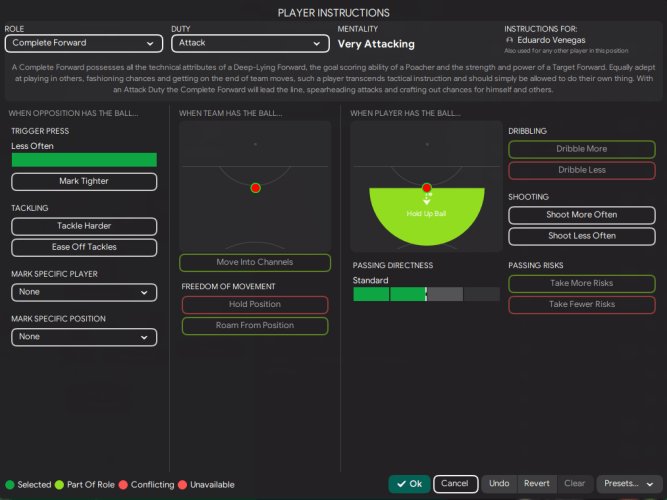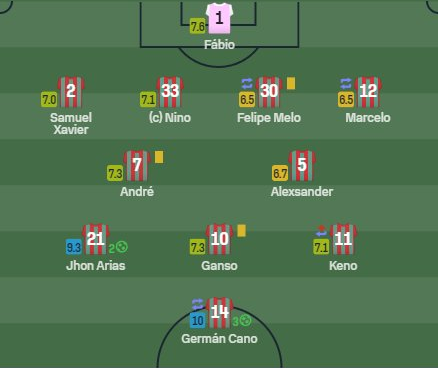Thread
Today we will look at striker roles and focus on what each role does, how you can implement it and what to expect #FM23 #FootballManager
Understanding The Striker Roles
To start with, though, I thought it would be a good idea to have a look at the striker roles and… twitter.com/i/web/status/1…
Today we will look at striker roles and focus on what each role does, how you can implement it and what to expect #FM23 #FootballManager
Understanding The Striker Roles
To start with, though, I thought it would be a good idea to have a look at the striker roles and… twitter.com/i/web/status/1…
The Creative Striker
These types of strikers are creators, so they are the support. This means they need players around them who can finish the chances they create. All of these types of strikers will likely play and provide other people with the ball, whether it be rushing… twitter.com/i/web/status/1…
These types of strikers are creators, so they are the support. This means they need players around them who can finish the chances they create. All of these types of strikers will likely play and provide other people with the ball, whether it be rushing… twitter.com/i/web/status/1…
Support Strikers
These differ from creative strikers because they don’t have as much creative freedom or roaming. Don’t mistake this for not being able to create chances though, as that’s not true and they can be creative and create lots of chances for their teammates.
However,… twitter.com/i/web/status/1…
These differ from creative strikers because they don’t have as much creative freedom or roaming. Don’t mistake this for not being able to create chances though, as that’s not true and they can be creative and create lots of chances for their teammates.
However,… twitter.com/i/web/status/1…
Attacking Strikers
These are the striker roles that are the more regular goalscoring ones. They rely heavily on supply, and if you use any of these roles, then you need to figure out how you will get the ball to them and which players will be able to offer support to them.
If… twitter.com/i/web/status/1…
These are the striker roles that are the more regular goalscoring ones. They rely heavily on supply, and if you use any of these roles, then you need to figure out how you will get the ball to them and which players will be able to offer support to them.
If… twitter.com/i/web/status/1…
Creative Striker Role and Suited Systems
When using a creative striker role, you need to ask yourself a few questions:
Who is going to score the goals?
Who will supply those balls?
How will they provide that support?
Obviously, if you are using any of the strike roles that I… twitter.com/i/web/status/1…
When using a creative striker role, you need to ask yourself a few questions:
Who is going to score the goals?
Who will supply those balls?
How will they provide that support?
Obviously, if you are using any of the strike roles that I… twitter.com/i/web/status/1…

False Nine
Above, I use a false nine role because I also have an inside forward and a mezzala who gets into the opposition box often. Both of those roles are also attacking duties. What this means is that you need the striker to create space and be able to feed the ball to those… twitter.com/i/web/status/1…
Above, I use a false nine role because I also have an inside forward and a mezzala who gets into the opposition box often. Both of those roles are also attacking duties. What this means is that you need the striker to create space and be able to feed the ball to those… twitter.com/i/web/status/1…

Deep-Lying Forward
Now above, when I said the creative role you use doesn’t really matter, it doesn’t, but it can change how players react. If we take a look at the deep-lying forward we can see how it changes.
As you can see, the deep-lying forward holds up the ball, which… twitter.com/i/web/status/1…
Now above, when I said the creative role you use doesn’t really matter, it doesn’t, but it can change how players react. If we take a look at the deep-lying forward we can see how it changes.
As you can see, the deep-lying forward holds up the ball, which… twitter.com/i/web/status/1…

Trequartista
If we take a look at the trequartista too, we can see how this impacts the original way of playing with the false nine.
This role is quite drastic compared to the others because, essentially, it’s a free role for the player. It’s a very attacking, creative role,… twitter.com/i/web/status/1…
If we take a look at the trequartista too, we can see how this impacts the original way of playing with the false nine.
This role is quite drastic compared to the others because, essentially, it’s a free role for the player. It’s a very attacking, creative role,… twitter.com/i/web/status/1…

4-3-3 Support Examples
This is where things get a little trickier because, primarily, these are not creative roles initially (although they can be).
Target Forward
The only difference between this duty and the attack duty is that you can’t ask the player to hold the position… twitter.com/i/web/status/1…
This is where things get a little trickier because, primarily, these are not creative roles initially (although they can be).
Target Forward
The only difference between this duty and the attack duty is that you can’t ask the player to hold the position… twitter.com/i/web/status/1…

Pressing Forward
The whole action striker thrives on putting pressure on the opposition’s defensive players in the hopes of winning the ball back in a high position.
The pressing forward is actually my favourite lone striker role in the entire game. I just love what the player… twitter.com/i/web/status/1…
The whole action striker thrives on putting pressure on the opposition’s defensive players in the hopes of winning the ball back in a high position.
The pressing forward is actually my favourite lone striker role in the entire game. I just love what the player… twitter.com/i/web/status/1…

What Characteristics Characterise a Good Attacking Striker?
To create a goal scorer, you need someone or several people to provide the striker with chances he can convert. Then he will also need support to pass to, create space for him, or even occupy an opposing player for him.… twitter.com/i/web/status/1…
To create a goal scorer, you need someone or several people to provide the striker with chances he can convert. Then he will also need support to pass to, create space for him, or even occupy an opposing player for him.… twitter.com/i/web/status/1…
The Advanced Forward
The advanced forward is your typical spearhead. If you use this role, then you’d expect him to be the team’s highest goalscorer. If we use the above and ask ourselves the questions I outlined earlier, we start building a picture.
Who is going to score the… twitter.com/i/web/status/1…
The advanced forward is your typical spearhead. If you use this role, then you’d expect him to be the team’s highest goalscorer. If we use the above and ask ourselves the questions I outlined earlier, we start building a picture.
Who is going to score the… twitter.com/i/web/status/1…

Complete Forward
Depending on the duty you use here, I’d likely make some subtle changes to the tactic that I posted as I feel it’s needed. The complete forward is a jack of everything; he can do it all. But a bit like the deep-lying forward, I feel he works really well with… twitter.com/i/web/status/1…
Depending on the duty you use here, I’d likely make some subtle changes to the tactic that I posted as I feel it’s needed. The complete forward is a jack of everything; he can do it all. But a bit like the deep-lying forward, I feel he works really well with… twitter.com/i/web/status/1…

Poacher
The poacher is that annoying role that plays on the shoulder of the last defender and will pounce on any mistake or timing issue the defender makes. It can be a thorn in anyone’s side at times.
In my opinion, this player thrives in a 4-3-3 when he has a playmaker on the… twitter.com/i/web/status/1…
The poacher is that annoying role that plays on the shoulder of the last defender and will pounce on any mistake or timing issue the defender makes. It can be a thorn in anyone’s side at times.
In my opinion, this player thrives in a 4-3-3 when he has a playmaker on the… twitter.com/i/web/status/1…

Two Or More Striker Formations
I’ve mainly stuck to a one-striker role system as I felt the post was getting way too long and wanted to try to keep it all relevant. I will touch upon other striker formations a little bit.
Typically, in a two-striker role system, you’d want to… twitter.com/i/web/status/1…
I’ve mainly stuck to a one-striker role system as I felt the post was getting way too long and wanted to try to keep it all relevant. I will touch upon other striker formations a little bit.
Typically, in a two-striker role system, you’d want to… twitter.com/i/web/status/1…
Like usual, if you've enjoyed the thread please leave a comment, like and share it please. Hope you enjoyed it :) #FM23 #FootballManager
• • •
Missing some Tweet in this thread? You can try to
force a refresh











